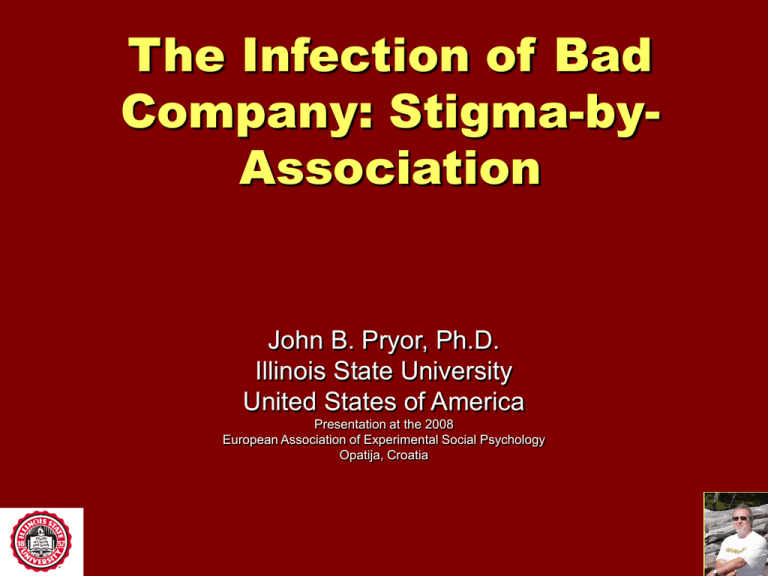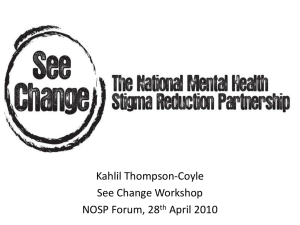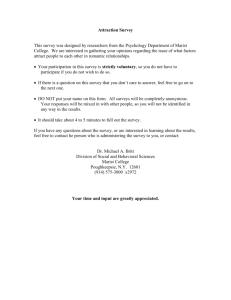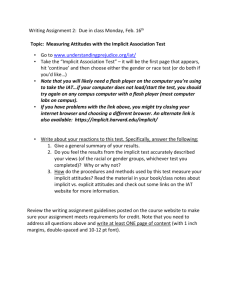The Infection of Bad Company: Stigma-by
advertisement

The Infection of Bad Company: Stigma-byAssociation John B. Pryor, Ph.D. Illinois State University United States of America Presentation at the 2008 European Association of Experimental Social Psychology Opatija, Croatia My collaborators • • • • Glenn D. Reeder Andrew Monroe Arati Patel Briana Muehlbauer Outline of Today’s Talk 1) What is a stigma? Some basic concepts. 2) A dual process model of reactions to stigma 3) Application of the dual process model to stigma-byassociation effects 4) Study 1: Obese Relatives 5) Study 2: Smoking Friends 6) Study 3: Sitting with Black Guys 7) Conclusions Goffman (1963) defined stigma as “an undesired differentness from what we had anticipated.” “By definition, we believe the person with a stigma is not quite human.” “We construct a stigma-theory, an ideology to explain his inferiority and account for the danger he represents, sometimes rationalizing an animosity based upon other differences, such as those of social class (p. 5).” Erving Goffman (1963) identified three basic types of stigma: - abominations of the body - moral character flaws - tribal stigmas an abomination of the body Persons with Disabilities an abomination of the body Persons with HIV/AIDS an abomination of the body Obese People an abomination of the body Persons with facial dermatitis blemishes of individual moral character Persons with Mental Illness blemishes of individual moral character Homosexual People blemishes of individual moral character Drug addict blemishes of individual moral character Smoker tribal stigma of race, nation, religion, family, or other social group African American tribal stigma of race, nation, religion, family, or other social group Japanese Korean tribal stigma of race, nation, religion, family, or other social group Muslim cleric tribal stigma of race, nation, religion, family, or other social group Mexican All of these stigmas evoke negative implicit attitudes ABOMINATIONS OF THE BODY • persons with disabilities (Pruett & Chan, 2006) • people with AIDS (Neumann, Hulsenbeck, & Seibt, 2004) • obese persons (Bessenoff & Sherman, 2000; Wang, Brownell, & Wadden, 2004) • people with facial dermatitis (Grandfield, Thomson, & Turpin, 2005) MORAL CHARACTER FLAWS • persons with mental illness (Teachman, Wilson, & Komarovskaya, 2006) • homosexuals (Jellison, McConnel, & Gabriel, 2004) • drug abusers (Brener, von Hippel, & Kippax, 2007) • people who smoke (Pryor, 2007) TRIBAL STIGMAS • White Americans have negative implicit attitudes toward Black Americans (Kawakami, Phills, Steele, & Dovidio, 2007) • Japanese have negative implicit attitudes toward Koreans and visa versa (Greenwald, McGhee, & Schwartz, 1998) • Christians have negative implicit attitudes toward Muslims (Park, Felix, & Lee, 2007) • Hispanics have negative implicit attitudes toward other Hispanics who have a darker skin color (Uhlmann, Dasgupta, Elgueta, Greenwald, Swanson, 2002) A Dual Process Model of Reactions to Stigmas Pryor, Reeder, Yeadon, & Hesson-McInnis (2004) Stigma Reflexive Processes evokes Negative Affective Reaction Avoidance Behavior A Dual Process Model of Reactions to Stigmas Stigma Reflexive Processes Negative Affective Reaction Avoidance Behavior Deliberative Processes •Attributional Analyses •PC concerns •Ideological Rationalizations Positive or Negative Affect Approach or Avoidance Behavior REFLEXIVE PROCESSES DELIBER ATIVE PROCESSES Onset Spontaneous when stigma is encountered Requires tim e, motivation, & cognitive resources Role of emotion Emotions are evoked by the stigma Emotions are often negative (e.g., disgus t, fear, uneasiness, etc.) Emotions are the products of cognitive processes Emotions may be positive (e.g., sympathy) or negative (e.g., irritation) Role of cognition Cognitions (e.g., labels) trigge r Attributional cognitions moderate emotions and motor responses reflexive reactions Consideration of personal values & social appropriateness Characteristic Avoidance behavior Approach or avoidance Pro-social behavior or social exclusion Theoretical origins Sociali zation Higher order cognitive processes Associative learning or evolved instincts Pryor, Reeder, Monroe & Patel (in press) Goffman’s 4th Type of Stigma: “Courtesy Stigma” or Stigma-by-Association Goffman theorized that stigma is spread by social structure associations. “Thus, the loyal spouse of a mental patient, the daughter of an ex-con, the parent of the cripple, the friend of the blind, the family of the hangman, are all obliged to share some of the discredit of the stigmatized person to whom they are related (p. 30).” “Sorority Evictions Raise Issue of Looks and Bias” “Worried that a negative stereotype of the sorority was contributing to a decline in membership that had left its Greek-columned house here half empty, Delta Zeta’s national officers interviewed 35 DePauw (University) members in November, quizzing them about their dedication to recruitment. They judged 23 of the women insufficiently committed and later told them to vacate the sorority house. The 23 members included every woman who was overweight. They also included the only Korean and Vietnamese members. The dozen students allowed to stay were slender and popular with fraternity men — conventionally pretty women the sorority hoped could attract new recruits.” Sam Dillon, February 25, 2007 courtesy stigma - acquired through social structure associations Spouse of Obese Person courtesy stigma - acquired through chosen affiliation Friend of Smoker courtesy stigma - acquired through chosen affiliation Acquaintance of a Black Man How does stigma-byassociation work? automatically evokes Negative Affective Reaction A Reflexive Process Three studies, three stigmas: Obesity Smoking Race Some common elements: 1. Use of Affective Misattribution Procedure to measure implicit anti-stigma attitudes 2. Measurement of explicit attitudes with feeling thermometers & Likert scales 3. Measurement of PC concerns Some hypotheses • Stigma-by-association effects are driven by reflexive processes • The potential for stigma-by-association is related to the strength of implicit attitudes evoked by a stigma • Explicit stigma-related attitudes will not be connected to stigma-by-association effects • PC concerns will be connected to explicit, but not implicit anti-stigma attitudes Study 1: Obese Relatives Affective Misattribution Procedure (AMP): Measuring Implicit Anti-Fat Attitudes • Before and after photos of 30 women taken from commercial weight-loss websites Make rating of pictograph before 1 second 1 second Make rating of pictograph after signal photo pictograph rating Ratings of Chinese Pictographs Following Photos of Women Before and After Weight Loss 0.7 Pleasantness of Pleasantness of Pictographs Pictographs 0.6 0.5 0.4 0.3 0.2 0.1 0 After Weight Loss Before Weight Loss Preceding Photo Measures of Explicit Attitudes • Feeling thermometers (0-100 favorability ratings) • Likert Scale (Crandall’s 1994 Anti-Fat Attitudes Scale) – examples: – “I really don’t like fat people very much” – “One of the worst things that could happen to me would be if I gained 25 pounds” – “Fat people tend to be fat pretty much through their own fault.” conditions Thin Relative Basic Procedure of Photo Rating Task POSITIVE NEGATIVE Heavy Relative 3 sec. 3 sec. degrees 100° 90° 80° 70° 60° 50° 40° 30° 20° 10° 0° Extremely attractive Very attractive Quite attractive Fairly attractive Slightly attractive Neither attractive nor unattractive Slightly unattractive Fairly unattractive Quite unattractive Very unattractive Extremely unattractive rating POSITIVE NEGATIVE degrees 100° 90° 80° 70° 60° 50° 40° 30° 20° 10° 0° Extremely attractive Very attractive Quite attractive Fairly attractive Slightly attractive Neither attractive nor unattractive Slightly unattractive Fairly unattractive Quite unattractive Very unattractive Extremely unattractive 32 men were rated in 2 conditions Relationship of Implicit Anti-Fat Attitudes to Evaluations of Men with Thin and Fat Relatives Evaluation of Associated Men 54 52 50 48 thin relatives fat relatives 46 44 42 40 - 1 SD AMP + 1 SD AMP Implicit Anti-Fat Bias Study 2: Smoking Friends Modified AMP: Measure of Implicit Attitudes toward Smokers QuickTime™ and a TIFF (LZW) decompressor are needed to see this picture. 1 second 1 second a dna ™emiTkciuQ rosserpmoced )WZL( FFIT .erutcip siht ees ot dedeen era signal photo How pleasant is the painting? abstract painting How pleasant is the painting? rating Ratings of Abstract Paintings Following Photos of Smokers and Non-Smokers 0.4 Pleasantness of Pleasantness of Paintings Paintings 0.3 0.2 0.1 0 -0.1 non-smokers -0.2 -0.3 Preceding Photo smokers Basic Procedure of Photo Rating Task Smoker POSITIVE NEGATIVE Non-Smoker 2 sec. 2 sec. degrees 100° 90° 80° 70° 60° 50° 40° 30° 20° 10° 0° Extremely attractive Very attractive Quite attractive Fairly attractive Slightly attractive Neither attractive nor unattractive Slightly unattractive Fairly unattractive Quite unattractive Very unattractive Extremely unattractive rating POSITIVE NEGATIVE degrees 100° 90° 80° 70° 60° 50° 40° 30° 20° 10° 0° Extremely attractive Very attractive Quite attractive Fairly attractive Slightly attractive Neither attractive nor unattractive Slightly unattractive Fairly unattractive Quite unattractive Very unattractive Extremely unattractive •Participants rated the attractiveness of 32 men & 32 women •Half were accompanied by smokers & half by non-smokers Relationship of Implicit Anti-Smoker Attitudes to Attractiveness Ratings of People Accompanied by Smokers and Non-Smokers 50 Attractiveness Attractiveness 49 48 47 Non-Smokers Smokers 46 45 44 43 -1 SD AMP +1 SD AMP Implicit Anti-Smoker Attitudes Study 3: Sitting with Black Guys 30 White Faces Measuring Implicit Anti-Black Attitudes with the AMP Make rating of pictograph 1 sec 30 Black Faces 1 sec Make rating of pictograph signal pictograph rating Ratings of Chinese Pictographs following Photos of White and Black Men 0.45 Pleasantness of Pleasantness of Pictographs Pictographs 0.4 0.35 0.3 0.25 0.2 0.15 0.1 0.05 0 Black White Preceding Photo Manipulation of Arbitrary Association Job candidate seated with a White employee Job candidate seated with a Black employee Participants examined application file of applicant for an IT job. Relationship of Implicit Anti-Black Attitudes to Hiring Reccommendations to Job Applicants Arbitrarily Associated with White or Black Men 1 Hiring Reccommendations 0.8 0.6 0.4 0.2 0 -0.2 -1 SD AMP +1 SD AMP -0.4 -0.6 -0.8 -1 -1.2 Implicit Anti-Black Attitudes White Black Correlations of the Implicit Anti-Stigma Attitude and the Two Explicit Attitude Measures with Motivation to Control Correlations with IMS 0 -0.1 -0.15 -0.03 -0.05 -0.05 -0.13-0.14 -0.2 -0.25 -0.3 * -0.35 -0.37 -0.4 ** -0.33-0.33 * -0.38 * -0.44 -0.45 Obesity Smokers Race Three Stigma Studies Implicit Attitudes Feeling Thermometers Likert Scales * Significant correlations with explicit attitudes Correlations Between Explicit Attitude Measures and Implicit Attitude Measures across Three Studies 0.32 Correlations 0.35 0.3 0.25 0.2 0.15 0.26 * 0.2 * 0.17 0.18 * * 0.11 0.1 0.05 0 Obesity Explicit Measures Likert Scales Feeling Thermometers Smokers Race Stigma Studies Conclusions •The ability of a stigma to “infect” associated others is related to the degree to which the stigma evokes spontaneous affect. •Stigma-by-association seems to largely involve reflexive processes. •The current studies examined individual differences in implicit attitudes as moderators of this process. Some stigmas may evoke spontaneous affect for almost all people. Stigma-by-association is a well known phenomenon • "…and keep them (children) from all ill, especially the infection of bad company." John Locke (1632–1704) from Some Thoughts Concerning Education. • "Associate yourself with men of good quality if you esteem your own reputation for 'tis better to be alone than in bad company." George Washington (1732 1799) The infection of bad company? A silver lining to the dark cloud… A stigma automatically evokes negative affect and this affect spreads to associated others Aarrgg!!





